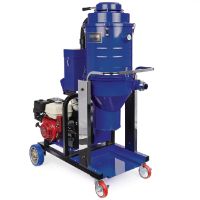Essential road marking removal equipment
Removing road paint, thermoplastics and tape calls for special equipment
GRINDING AND BLASTING ARE THE MOST COMMON TECHNIQUES TO REMOVE ROAD PAINT
Road markings are designed for the long run, but sometimes they need to be removed. For instance when a traffic situation changes or a parking lot is redesigned. Special tools and techniques enable you to remove stripes and pavement markings efficiently.
Removing existing road striping or pavement markings is a real challenge. The markings must be efficiently removed without causing damage to the road surface. Sometimes the lines are even harder than the underlying asphalt. Moreover the materials used in asphalt are very porous, allowing road paint to penetrate the surface pores. Reason enough to get yourself the right equipment for your road paint removal jobs.
Grinding
A grinder or scarifier is the traditional tool for fast and clean road marking removal. These specialized machines enable you to remove all types of lines found on parking lots or roadways. Overall, grinding is the fastest, most cost-efficient way for removing pavement markings. It is the most appropriate road marking removal technique, especially for removing lines that will be replaced by new markings on the same location. Even if the pavement will remain, grinding is still the best method for removing traffic paint, thermoplastic, epoxy coatings and other materials. Using the proper grinding tool, operated by an experienced worker, will minimize the risk of scarring the road surface.
Increase your line removal productivity
With an engine-propelled grinder you can double your line removal productivity. A user-friendly ride-on system, like Graco’s LineDriver, transforms your traditional grinding machine into an easy-to-move unit.
Choose the best grinder for the job
When choosing the best grinding tool for your needs, you must consider which materials you will be removing and how fast you want to complete the job. The smallest scarifiers are able to remove traffic paint and thermoplastics and can be used to smoothen uneven surfaces. The removal speed is limited to approximately 30 m2/hr when walking. The most powerful scarifiers can also be used for the removal of epoxy coatings and for inlay and grooving applications. With a LineDriver they can reach up to a removal speed of 195 m2/hr.
Other line removal methods
- Waterblasting: This technique uses hog pressure water to remove markings from concrete and asphalt. The needle sharp water jets can even pulverize temporary marking tape. Waterblasting causes the least amount of scarring but is not powerful enough for the smoothening of uneven surfaces, nor for inlay and grooving applications.
- Sandblasting: Using a low pressure sand jetting system, this technique captures line marking material. Sandblasting only uses minimal amounts of water and abrasives, making it a good solution for indoor applications.
Related Articles
How to paint different types of road markings
There are different types of road marking lines, each calling for a specific spraying method
How to apply outdoor pavement markings such as parking lot lines and road markings
Outdoor markings for pavement on roads and car parks are very diverse. With the right equipment you can work fast and efficient.
Which material or line marking paint to use
Paint, epoxy, thermoplastics, ... We tell you everything about the different road marking materials





